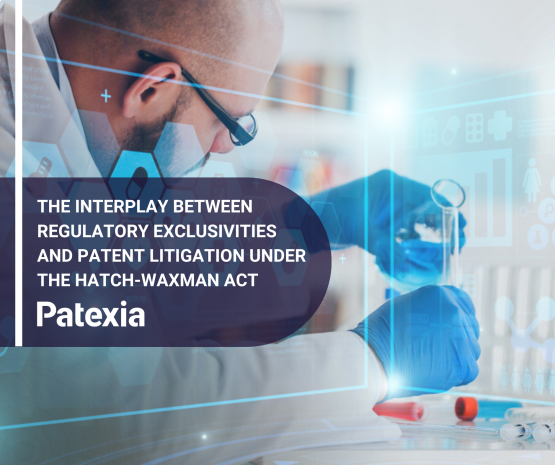The Interplay between Regulatory Exclusivities and Patent Litigation under the Hatch-Waxman Act

The Hatch-Waxman Act, officially known as the Drug Price Competition and Patent Term Restoration Act, revolutionized the pharmaceutical industry by balancing the interests of brand-name drug manufacturers and generic drug manufacturers. It introduced the concept of regulatory exclusivities and established a framework for resolving patent disputes. This article explores the interplay between regulatory exclusivities and patent litigation under the Hatch-Waxman Act, highlighting the significant role they play in promoting innovation and access to affordable medications.
Hatch-Waxman Act Background:
Enacted in 1984, the Hatch-Waxman Act aimed to expedite the availability of lower-cost generic drugs while maintaining incentives for brand-name drug innovation. It achieved this by introducing the Abbreviated New Drug Application (ANDA) pathway, which allowed generic manufacturers to demonstrate bioequivalence to a brand-name drug without conducting extensive clinical trials. This streamlined approval process significantly reduced the time and cost required for generic drug entry into the market.
Regulatory Exclusivities:
One of the key provisions of the Hatch-Waxman Act is the establishment of various regulatory exclusivities, which provide incentives to brand-name drug manufacturers. These exclusivities grant a period of market exclusivity to the innovator drug, during which time generic competitors are prohibited from entering the market. Let's explore some of the important exclusivities and their duration:
- Orphan Drug Exclusivity (ODE): ODE grants seven years of market exclusivity to drugs that are designated for the treatment of rare diseases, providing an incentive for manufacturers to develop medications for patients with unmet medical needs.
- New Chemical Entity Exclusivity (NCE): NCE exclusivity provides five years of market exclusivity to brand-name drugs that contain an active ingredient not previously approved by the Food and Drug Administration (FDA). This exclusivity allows the innovator company to recoup its investment in research and development and enjoy a period of monopoly profits.
- Generating Antibiotic Incentives Now (GAIN) Exclusivity: GAIN exclusivity can add an additional five years to certain exclusivities, such as NCE exclusivity, for drugs that target specific antibiotic-resistant pathogens. This provision aims to stimulate the development of new antibiotics to combat drug-resistant infections.
- New Clinical Investigation Exclusivity: This exclusivity provides three years of market exclusivity to drugs that have undergone significant clinical investigations, encouraging companies to invest in conducting studies to support the drug's approval.
- Pediatric Exclusivity (PED): PED adds an additional six months of exclusivity to existing patents or exclusivities when a drug manufacturer conducts pediatric studies to determine the drug's safety and efficacy in children. This incentive promotes research into pediatric drug use and ensures proper labeling for pediatric patients.
- Patent Challenge (PC): PC exclusivity grants 180 days of exclusivity for ANDAs only. It allows the first generic manufacturer to successfully challenge a brand-name drug patent through litigation to enjoy a period of market exclusivity.
- Competitive Generic Therapy (CGT): CGT exclusivity, also for ANDAs only, provides 180 days of exclusivity to generic manufacturers who are the first to market a drug that is considered off-patent but lacks generic competition. This provision encourages competition and aims to address drug shortages in the market.
Patent Litigation:
Alongside regulatory exclusivities, the Hatch-Waxman Act established a framework for resolving patent disputes between brand-name and generic manufacturers. When a generic manufacturer submits an ANDA, it must certify one of four possibilities regarding relevant patents. These certifications are known as Paragraph IV certifications. A Paragraph IV certification asserts that the listed patent is invalid, unenforceable, will expire before generic product is released or will not be infringed by the generic product at all. This certification is the trigger for patent litigation, as it provides the brand-name manufacturer the opportunity to sue the generic manufacturer for patent infringement.
The litigation process that follows is known as the Hatch-Waxman patent litigation, during which the district court evaluates the patent's validity and infringement claims. If the court rules in favor of the generic manufacturer and finds the patent invalid or not infringed, the generic drug can be approved for market entry. However, if the court rules in favor of the brand-name manufacturer, the patent remains in force, preventing generic entry until its expiration.
Interplay between Regulatory Exclusivities and Patent Litigation:
The interplay between regulatory exclusivities and patent litigation under the Hatch-Waxman Act is complex yet vital in shaping the pharmaceutical landscape. Generic manufacturers often challenge the validity and scope of brand-name drug patents to expedite market entry, leveraging the Paragraph IV certification process.
In some instances, generic manufacturers may choose to launch "at-risk" generic products before patent litigation is resolved. This means they risk damages and injunctive relief if the court ultimately upholds the patent. However, launching at-risk generics can put pressure on the brand-name manufacturer to settle the litigation and allow the generic entry, thereby avoiding lengthy and costly legal battles.
The Hatch-Waxman Act introduced a carefully crafted framework that balances the interests of brand-name and generic drug manufacturers. Regulatory exclusivities incentivize innovation by providing market exclusivity to brand-name drugs, while patent litigation mechanisms ensure the integrity of the patent system. This interplay between regulatory exclusivities and patent litigation has facilitated the availability of affordable generic medications, leading to increased access to healthcare for patients while encouraging continued innovation in the pharmaceutical industry.